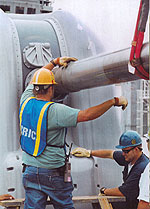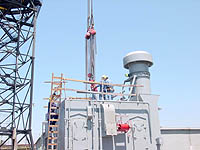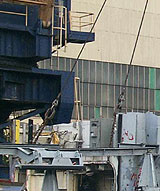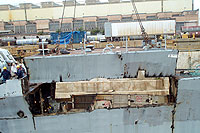Shipyard Employment eTool
Materials Handling (including Gear and Equipment for Rigging) >> Ropes, Chains, and Slings
Ropes, chains, and slings are attached to loads that are being lifted or moved. Failure of this equipment can cause the load to fall, injuring workers.
The following topics are addressed below:
- Natural (manila) and synthetic rope and slings
- Synthetic web slings
- Wire rope and wire-rope slings
- Chains and chain slings
Note: Confined space entry is one of the leading hazards associated with barge cleaning. Review the Shipbreaking: Confined/Enclosed Spaces and Other Dangerous Atmospheres chapter for information on how to protect workers from this hazard.

Potential Hazard
Failure of slings due to abrasion, cuts, overloading, improper storage and use, environmental conditions and chemical deterioration may result in serious accidents.
Requirements and Example Solutions
- The "safe working load" of manila rope and manila rope slings must not be exceeded. [29 CFR 1915.112(a)(1)]
- The safe working load of conventional three-strand construction-fiber rope must not be exceeded. [29 CFR 1910.184(h)(1)(i)]
- Splices and eye splices of fiber rope, manila rope, synthetic-fiber rope slings must be in accordance with minimum requirements and manufacturer's recommendations. [29 CFR 1910.184(h)(3)] (See Figure 2.)
- Knots must not be used in lieu of splices. [29 CFR 1910.184(h)(3)(v)]
- Clamps not designed specifically for fiber ropes must not be used for splicing. [29 CFR 1910.184(h)(3)(vi)]
- Fiber rope slings must not be used if end attachments in contact with the rope have sharp edges or projections.
- Natural- and synthetic-fiber rope slings must be immediately removed from service if any of the following conditions are present:
- Abnormal wear. [29 CFR 1910.184(h)(5)(i)]
- Powdered fiber between strands. [29 CFR 1910.184(h)(5)(ii)]
- Broken or cut fibers. [29 CFR 1910.184(h)(5)(iii)]
- Variations in the size or roundness of strands. [29 CFR 1910.184(h)(5)(iv)]
- Discoloration or rotting. [29 CFR 1910.184(h)(5)(v)]
- Distortion of hardware in the sling. [29 CFR 1910.184(h)(5)(vi)]
Note: Only fiber rope slings made from new rope must be used. Use of repaired or reconditioned fiber rope slings is prohibited. [29 CFR 1910.184(h)(6)]

Potential Hazard
Failure of slings due to broken stitching, perforations, burns, abrasion, cuts, overloading, improper storage and use, environmental conditions and chemical deterioration may result in serious accidents.
Requirements and Example Solutions
- Slings must be marked with rating capacity. [29 CFR 1910.184(i)(1)]
- Fittings must be:
- Minimum breaking strength, equal to that of the sling. [29 CFR 1910.184(i)(3)(i)]
- Free of sharp edges. [29 CFR 1910.184(i)(3)(ii)]
- Stitching must be used to attach end fittings to webbing and to form eyes. [29 CFR 1910.184(i)(4)]
- The safe working load of synthetic web slings must not be exceeded. [29 CFR 1910.184(i)(5)]
- Precautions should be taken when selecting and using web slings around chemicals and in extreme temperatures. [29 CFR 1910.184(i)]
- If repaired, slings must be in accordance with manufacturer's specifications and proof tested. [29 CFR 1910.184(i)(8)(i) and (ii)]
- Synthetic-web slings must be immediately removed from service if any of the following conditions are present:
- Acid or caustic burns. [29 CFR 1910.184(i)(9)(i)]
- Melting or charring of any part of the sling surface. [29 CFR 1910.184(i)(9)(ii)]
- Snags, punctures, tears or cuts. [29 CFR 1910.184(i)(9)(iii)]
- Broken or worn stitches. [29 CFR 1910.184(i)(9)(iv)]
- Distortion of fittings. [29 CFR 1910.184(i)(9)(v)]

Potential Hazard
Failure of slings due to broken wires, kinking, crushing, bird caging, overloading, improper storage and use and environmental conditions may result in serious accidents.
Requirements and Example Solutions
- The safe working load of wire rope and wire rope slings must not be exceeded. [29 CFR 1915.112(b)(1)]
- Wire-rope slings do not require identification tags.
- To determine the rating, the size and type of rope must be known.
- Protruding ends of strands in splices on slings and bridles must be covered or blunted. [29 CFR 1915.112(b)(2)]
-
Where U-bolt wire rope clips are used to form eyes:

- Number and and spacing of clips must be in accordance with Table G-6 of 29 CFR 1915.118. [29 CFR 1915.112(b)(3)]
- The U-bolt must be applied so that the "U" section is in contact with the dead end of the rope. [29 CFR 1915.112(b)(3)]
- "Never saddle a dead horse." -- Rigging Industry common phrase.
-
Wire rope must not be secured by knots. [29 CFR 1915.112(b)(4)]

- Safe operating temperatures must not be exceeded. [29 CFR 1910.184(f)(3)]
- Wire rope slings must be immediately removed from service if any of the following conditions are present: (See Figure 6.)
-
Ten randomly distributed broken wires in one rope lay, or five broken wires in one strand in one rope lay. [29 CFR 1910.184(f)(5)(i)]

- Wear or scraping of one-third the original diameter of outside individual wires. [29 CFR 1910.184(f)(5)(ii)]
- Kinking, crushing, bird caging, or any other damage resulting in distortion of the wire rope structure. [29 CFR 1910.184(f)(5)(iii)]
- Evidence of heat damage. [29 CFR 1910.184(f)(5)(iv)]
- End attachments that are cracked, deformed, or worn. [29 CFR 1910.184(f)(5)(v)]
-
Hooks that have been opened more than 15 percent of the normal throat opening measured at the narrowest point or twisted more than 10 degrees from the plane of the unbent hook. [29 CFR 1910.184(f)(5)(vi)]

- Corrosion of the rope or end attachments. [29 CFR 1910.184(f)(5)(vii)]
-

Potential Hazard
Failure of chains and chain slings are typically due to overloading, sharp edges, environmental deterioration, and exposure to heat (for example, from electrical arc, welding, and cutting torches). Use of damaged chains and chain slings may result in serious accidents.
Requirements and Example Solutions
- The safe working load of chains and chain slings must not be exceeded. [29 CFR 1915.112(c)(1)]
- All chain slings including hooks and fasteners, must be visually inspection before use. [29 CFR 1915.112(c)(2) and 29 CFR 1915.113(b)(3)]
- All chains and chain slings must be thoroughly inspected every 3 months and tagged. [29 CFR 1915.112(c)(2)]
-
Chain slings including hooks must be removed from service when defective. [29 CFR 1915.112(c)(4) and 29 CFR 1915.113(b)(3)] This may include components that are:

- Stretched
- Kinked
- Bent
- Twisted
- Repaired chains must be proof tested before returning to service. [29 CFR 1915.112(c)(5)]
- A load must not be lifted with a chain having a kink or knot in it. [29 CFR 1915.112(c)(7)]
- A chain must not be shortened by bolting, wiring, or knotting. [29 CFR 1915.112(c)(7)]

Additional Resources
- Please refer to the US Department of Energy's DOE-STD-1090-2011; Hoisting and Rigging Standard for additional rigging material.

